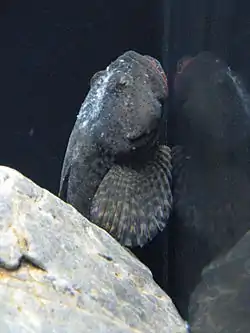杜父魚
Chinese
| fabricate; restrict; to prevent | father | fish | ||
|---|---|---|---|---|
| trad. (杜父魚) | 杜 | 父 | 魚 | |
| simp. (杜父鱼) | 杜 | 父 | 鱼 | |
| variant forms | 渡父魚/渡父鱼 | |||
Pronunciation
Japanese
Etymology 1

| Kanji in this term | ||
|---|---|---|
| 杜 | 父 | 魚 |
| Jinmeiyō | Grade: 2 | Grade: 2 |
| Irregular | ||
Apparently from 鎌切 (kamakiri, “mantis”), possibly from the way the pectoral fins are smooth on the upper edge and webbed with sharp rays along the lower edge, somewhat similar to a mantis's forelegs, or from the way the fish lies in wait to grab prey, similar to a mantis.
Pronunciation
Alternative forms
Noun
杜父魚 (hiragana かまきり, katakana カマキリ, rōmaji kamakiri)
- a fourspine sculpin (species Cottus kazika); very similar to the kajika (see below), but larger
Synonyms
- 鮎掛 (ayukake) (more common)
- 杜父魚 (kakubutsu) (rare; see below)
Usage notes
The synonym 鮎掛 (ayukake) is much more commonly used, to avoid confusion between the fish and the insect senses of the term kamakiri.
Note that the species name Cottus kazika does not refer to the kajika (see below), but rather to the kamakiri or ayukake.
Pronunciation
Noun
杜父魚 (hiragana かくぶつ, rōmaji kakubutsu)
- (rare) a fourspine sculpin (species Cottus kazika); very similar to the kajika (see below), but larger
Usage notes
The kamakiri reading is more common for the fish sense. However, the synonym 鮎掛 (ayukake) is much more commonly used, to avoid confusion between the fish and the insect senses of the term kamakiri.
Etymology 3

| Kanji in this term | ||
|---|---|---|
| 杜 | 父 | 魚 |
| Jinmeiyō | Grade: 2 | Grade: 2 |
| Irregular | ||
Possibly from 河鹿 (kajika, literally “river deer”), the short name for 河鹿蛙 (kajika-gaeru, “Japanese river frog”), from the way the fish can resemble a young frog or tadpole as it sits on the bottom.
Alternatively, possibly derived from the same roots as 河鹿 (kajika) in reference to the fish's use as food, ultimately as a compound of 河 (kawa, “river”) + 鹿 (shika, “deer”): /kawa ɕika/ → /kad͡ʑika/.
Noun
杜父魚 (hiragana かじか, katakana カジカ, rōmaji kajika)
- a Japanese fluvial sculpin (species Cottus pollux); very similar to the kamakiri (see above), but smaller
Synonyms
Etymology 4
| Kanji in this term | ||
|---|---|---|
| 杜 | 父 | 魚 |
| と Jinmeiyō |
ふ Grade: 2 |
ぎょ Grade: 2 |
| on’yomi | ||
Appears to be a borrowing from Middle Chinese 杜父魚 (MC duoX pɨoX|bɨoX ŋɨʌ). The kan'on, so a later borrowing after the end of the Old Japanese stage of the language.
Noun
杜父魚 (hiragana とふぎょ, rōmaji tofugyo)
- a Japanese fluvial sculpin (species Cottus pollux), more commonly known as 鰍 (kajika)
Usage notes
This reading is generally only used in contexts relating to China or the Chinese language.[4][1]
References
- 2006, 大辞林 (Daijirin), Third Edition (in Japanese), Tōkyō: Sanseidō, →ISBN
- 1998, NHK日本語発音アクセント辞典 (NHK Japanese Pronunciation Accent Dictionary) (in Japanese), Tōkyō: NHK, →ISBN
- 1997, 新明解国語辞典 (Shin Meikai Kokugo Jiten), Fifth Edition (in Japanese), Tōkyō: Sanseidō, →ISBN
- 1988, 国語大辞典(新装版) (Kokugo Dai Jiten, Revised Edition) (in Japanese), Tōkyō: Shogakukan